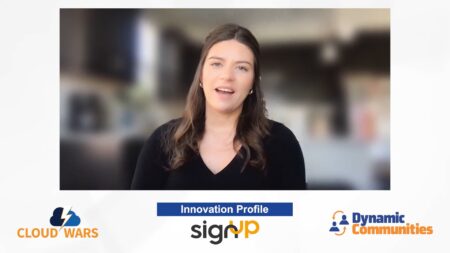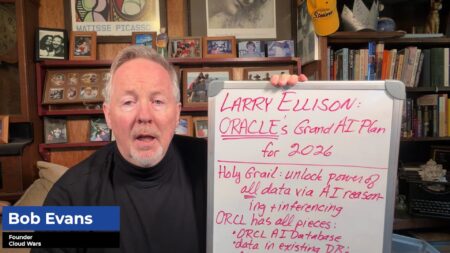Tap to pay, digital wallets, cryptocurrency, and virtual banking were not part of our everyday lives just a decade ago. However, many people still think of financial services as a “boring thing for accountants” or “number crunching.” On the flip side, organizations view trusted financial management as the lifeblood of their business strategies.
The financial services industry is so much more than dollars and cents. Subsets of finance span retail, wealth management, commercial banking, insurance, and so forth are all areas that fintech solutions have to harmonize. With this in mind, Day 4 of the week-long Industry Cloud Battleground focused on the disruptive challenges many are facing today. Further, financial technology innovations are equipping industry professionals with the tools they need to succeed.
Microsoft on Financial Services
Microsoft led with their mission to “support the customer journey for each industry, delivering an integrated customer experience.” This is the foundation for the Microsoft Cloud for Financial Services built with privacy, security, and regulatory compliance capabilities.
No company would succeed in finance without the critical role of data. Microsoft built an industry data model which helps ease interoperability and unifies data to accelerate insights and business workflows. On top of this, the trusted partner ecosystem extends the trusted cloud further by leveraging their unique expertise and tailored high-value solutions.
What were the key highlights that Microsoft focused on?
- Protect the perimeter. Microsoft collaborated with ClearBank, a fintech started in 2016, to shake up a 250-year-old marketplace. A critical component of the ClearBank business model was to protect its infrastructure from global cyber threats. Also, speed was crucial to success. The benchmark of a 300-millisecond transaction was set which would include point-to-point reconciliation, auditing, and completion. This model is now deployed around the world and can support 44,000 banks.
- Tech + industry experience. Azure Cognitive Services use AI to convert something analog to digital, such as a paper loan for example. The loan mortgage application process is then automated by the low-code/no-code automation platform. However, the tech wouldn’t be successful without experienced people to deliver the transformation. Microsoft is helping to upskill business professionals through a program launched in 2020 called the Enterprise Skills Initiative.
- Look at the big picture. Financial institutions span the globe and have infrastructures all over. Microsoft is co-innovating with its customers to provide deep integration and scalable solutions for a global economy. Microsoft operates in 47 different countries. So, it understands the need for confidentiality, performance, and security for financial markets, no matter the geographical location.
Workday on Financial Services
More than 70% of the financial services companies in the Fortune 500 are using Workday to digitally accelerate. The Workday solutions span banking, capital markets, investment management, insurance, and more. This experience positioned Workday to address the magnified disruption in the economic climate.
Moreover, operational spending continues to rise within financial services. The cost of talent keeps trending upward and many firms have to spend more to keep the talent that they have or to encourage new talent to come and join their organizations. As external growth opportunities continue to diminish, financial services firms are going to have to look closely at how they optimize their operational spending and find ways to create a path to profitability.
How does Workday energize its efforts in financial services?
- Build resiliency in fintech investments. Workday realizes that the volatility in the financial markets can be somewhat attributed to mergers and acquisitions. For example, the Bank of Montreal found that personnel experience was lacking across employees and managers and faced a skills gap due to their expanding footprint. Outdated systems weren’t effective and prohibited the scalability needed for modern finance. Workday helped the Bank of Montreal with a platform that is secure and flexible with the ability to engage its employees, automate processes, and integrate with disparate systems.
- Deliver a standard accounting model. There are many similarities flowing through the financial services industry and related sub-industries. Workday recognizes that a trusted, transparent, and accurate model is important. This model enables straight-through accounting rationalization, fuses together hundreds of millions of lines of data, and unlocks the insights to classify it and rationalize it to a common taxonomy.
- Streamline the auditing process. Artificial Intelligence and machine learning are built into the core Workday products. As a result, financial institutions can be better prepared for regulatory compliance rules and auditing. As an example, journal anomaly detection can intelligently conduct customer cash matching and expense protection to protect against expensive anomalies on expense report creation. The results are delivered in a relevant way to the right people with the right role relevance.
Salesforce on Financial Services
Many banks and insurance companies are still fighting a repetitive information complex. This causes consumers and financial professionals to enter the same information to open an account or get help with an insurance claim. Salesforce found that technology leaders are still gathering data in a very outdated manner. Additionally, many silos and disconnected systems still exist in conjunction with paper-based processes.
Today, consumer expectations dictate a deeply personalized experience. This forced many traditional financial companies to wonder if they needed to start from scratch to craft a digitally-enabled business. However, many leaders in banking and insurance are reaping the rewards of investing in solutions to help future-proof their business.
Salesforce listened to its customers and homed in on these priorities.
- Invest in an innovation strategy. Salesforce customers shared that they need digital acceleration to deliver true buyer value. This means seamlessly connecting to middle and back-office processes with digital process automation and service transformation layered throughout the transactional lifecycle. The outcome is customers are able to quickly deploy processes like underwriting, onboarding, and needs analysis.
- Empower digital currency. A few points emerged from Salesforce in this area. One area is thinking digital-first as the convergence of the physical and virtual worlds are a reality and create an urgency for hybrid operating models. Another area is the importance of a single source of truth for data. As the customer experience transpires across multiple apps and sites, trustworthy, actionable data needs to be surfaced for critical decision-making.
- Reimagine the service experience. A frictionless experience is not something many people attribute to their interactions with banks or insurance. For Salesforce, it’s important to provide a unified solution to its customers for establishing confidence in the transactional process.
Google Cloud on Financial Services
The industry needs innovation and client understanding. For Google Cloud, the best data infrastructure and AI capabilities define its core. Long-established financial businesses could realistically have 100+ years of data that needs to be modernized for today’s customers. Further, customers need to extract value from the data.
Another fundamental differentiator is that data is unique for a retail bank versus a commercial bank, or an issuer, or a life insurance company. Moreover, the quality and speed of the data are crucial where milliseconds in performance matter.
In what ways is Google Cloud becoming the digital infrastructure for financial entities?
- Protection of the process. Google Cloud works with its customers to create solutions for anti-money laundering, fraud detection for credit card transactions, and rethinking the regulatory space. The key message here is risk transformation at scale built on top of a zero-trust foundation.
- Activating the data. The topic of the “edge” is no longer a “nice to have”, but a necessity. If you can bring the data closer to the client, this can change the conversation and outcomes in the experiences. But, this approach requires a paradigm shift from the tech department owning the data to the business owning the data.
- Digitization of assets. The evolution of finance has come a long way, but it’s still a paper-laden industry. Google is helping customers redesign paper processes to streamline these steps. For example, AI is giving the mortgage industry a boost in the right direction through document processing. Data, images, logos, and more can be extracted automatically and fed into an automated process to create alerts, update systems, and provide a personalized experience.
Oracle on Financial Services
The notion that everyone has moved to the cloud is foolhardy. Oracle’s answer is to collaborate with customers in their digital journey of migrating to the cloud. Legacy systems weren’t created to ensure strong financial controls, automate security monitoring, and instill confidence in enterprise-wide analytics.
The days of currency in your wallet or pocket are fleeting fast. Oracle stated that less than 10% of the money in the world is physical with the remaining moving through “bits and bytes”. This stark reality defines where Oracle is investing its time and energy.
For Oracle, financial services are viewed through various lenses:
- Investment in finance modernization. Finance organizations require solutions that bring the back-office ERP together with the front office service teams. 70% to 80% of Oracle’s customers are looking to invest in bringing their finance systems into the modern era.
- Accommodate all forms of currency. Yes, most currency is digital today, but many people still use old forms of currency such as paper money and checks. While on the other end of the spectrum is cryptocurrency and mining for Ethereum. In the middle of this are financial services that need to bring these seemingly opposing ends together. Oracle’s solutions can span these needs, but they help customers recognize the competitive threats.
- Respond to real-world needs. A great example of this is Oracle’s collaboration with MasterCard. The Angeleno Card Initiative was formed to get money into the hands of citizens hit hardest by business shutdowns from COVID. This program helped 400,000 people to utilize no-fee debit cards in a short amount of time.
SAP on Financial Services
Customer centricity explains the way SAP is delivering solutions for financial institutions. Further, SAP is helping to blur the lines across various industries such as bringing banking and healthcare together. An integrated banking offering with SAP’s healthcare claims processing creates a delightful experience for customers.
Another aspect of SAP’s mindset is embedding solutions across industries. Car manufacturing companies are embedding insurance in the user experience. And, this trend will only continue until hardlines between traditional industries are no longer recognizable.
So, how is SAP delivering upon the customer-centricity premise?
- Fueling the fintech revolution. The last mile of digital transformation is usually the most difficult. SAP is looking to move through the last mile much quicker in a frictionless way. SAP’s goal is to extend financial services from back-office solutions through HR, procurement, and into the administrative domain.
- Challenge norms of competition. SAP is tapping into the innovative spirit started by traditional banks and insurers who have launched their own fintech acceleration hubs. The syntax SAP is using is “coopetition” which is a collaboration of competitors to build strong relationships with customers.
- Behavioral banking. The concept of behavioral banking, that SAP attributed to Discovery Bank, is essentially guiding and teaching customers to make better banking decisions. This visionary approach enhanced the customer experience in the context of everyday life to deliver frictionless personalization.






